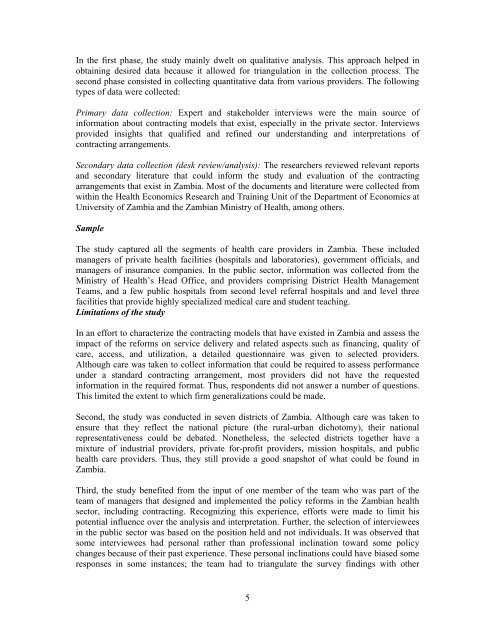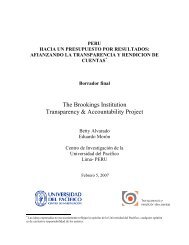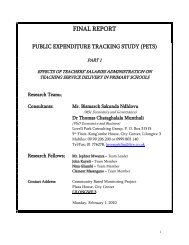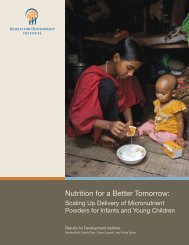Provider Purchasing and Contracting for Health Services_The Case
Provider Purchasing and Contracting for Health Services_The Case
Provider Purchasing and Contracting for Health Services_The Case
You also want an ePaper? Increase the reach of your titles
YUMPU automatically turns print PDFs into web optimized ePapers that Google loves.
In the first phase, the study mainly dwelt on qualitative analysis. This approach helped in<br />
obtaining desired data because it allowed <strong>for</strong> triangulation in the collection process. <strong>The</strong><br />
second phase consisted in collecting quantitative data from various providers. <strong>The</strong> following<br />
types of data were collected:<br />
Primary data collection: Expert <strong>and</strong> stakeholder interviews were the main source of<br />
in<strong>for</strong>mation about contracting models that exist, especially in the private sector. Interviews<br />
provided insights that qualified <strong>and</strong> refined our underst<strong>and</strong>ing <strong>and</strong> interpretations of<br />
contracting arrangements.<br />
Secondary data collection (desk review/analysis): <strong>The</strong> researchers reviewed relevant reports<br />
<strong>and</strong> secondary literature that could in<strong>for</strong>m the study <strong>and</strong> evaluation of the contracting<br />
arrangements that exist in Zambia. Most of the documents <strong>and</strong> literature were collected from<br />
within the <strong>Health</strong> Economics Research <strong>and</strong> Training Unit of the Department of Economics at<br />
University of Zambia <strong>and</strong> the Zambian Ministry of <strong>Health</strong>, among others.<br />
Sample<br />
<strong>The</strong> study captured all the segments of health care providers in Zambia. <strong>The</strong>se included<br />
managers of private health facilities (hospitals <strong>and</strong> laboratories), government officials, <strong>and</strong><br />
managers of insurance companies. In the public sector, in<strong>for</strong>mation was collected from the<br />
Ministry of <strong>Health</strong>’s Head Office, <strong>and</strong> providers comprising District <strong>Health</strong> Management<br />
Teams, <strong>and</strong> a few public hospitals from second level referral hospitals <strong>and</strong> <strong>and</strong> level three<br />
facilities that provide highly specialized medical care <strong>and</strong> student teaching.<br />
Limitations of the study<br />
In an ef<strong>for</strong>t to characterize the contracting models that have existed in Zambia <strong>and</strong> assess the<br />
impact of the re<strong>for</strong>ms on service delivery <strong>and</strong> related aspects such as financing, quality of<br />
care, access, <strong>and</strong> utilization, a detailed questionnaire was given to selected providers.<br />
Although care was taken to collect in<strong>for</strong>mation that could be required to assess per<strong>for</strong>mance<br />
under a st<strong>and</strong>ard contracting arrangement, most providers did not have the requested<br />
in<strong>for</strong>mation in the required <strong>for</strong>mat. Thus, respondents did not answer a number of questions.<br />
This limited the extent to which firm generalizations could be made.<br />
Second, the study was conducted in seven districts of Zambia. Although care was taken to<br />
ensure that they reflect the national picture (the rural-urban dichotomy), their national<br />
representativeness could be debated. Nonetheless, the selected districts together have a<br />
mixture of industrial providers, private <strong>for</strong>-profit providers, mission hospitals, <strong>and</strong> public<br />
health care providers. Thus, they still provide a good snapshot of what could be found in<br />
Zambia.<br />
Third, the study benefited from the input of one member of the team who was part of the<br />
team of managers that designed <strong>and</strong> implemented the policy re<strong>for</strong>ms in the Zambian health<br />
sector, including contracting. Recognizing this experience, ef<strong>for</strong>ts were made to limit his<br />
potential influence over the analysis <strong>and</strong> interpretation. Further, the selection of interviewees<br />
in the public sector was based on the position held <strong>and</strong> not individuals. It was observed that<br />
some interviewees had personal rather than professional inclination toward some policy<br />
changes because of their past experience. <strong>The</strong>se personal inclinations could have biased some<br />
responses in some instances; the team had to triangulate the survey findings with other<br />
5
















